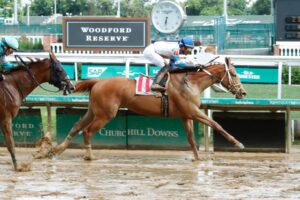In the early light of dawn, the world of thoroughbred racing awakens with a palpable sense of anticipation. Around the racetrack, teams of dedicated professionals are immersed in their meticulous morning routines, preparing each prized thoroughbred for the day’s challenges ahead.
Among these experts is an experienced bloodstock agent, whose discerning gaze evaluates each horse with precision. This moment, rich with excitement and thoughtful strategy, offers a vivid entry point into the intricate and thrilling world of thoroughbred racing, where a fundamental understanding of the sport’s essentials is as vital as the races themselves.

The Essence of Thoroughbred Racing
Thoroughbred racing, often hailed as the ‘Sport of Kings’, is more than just a test of speed and stamina; it’s a symphony of strategy, breeding, and care. It’s a global industry, contributing significantly to economies worldwide.
According to the American Horse Council, the racing sector contributes approximately $15 billion annually to the U.S. economy. But beyond these figures lies a world rich in tradition and innovation, where the lineage of a horse can be as talked about as the skills of the jockey.

Race Types and Their Unique Characteristics
Each race type in thoroughbred racing brings its unique flavor to the sport:
- Dirt Races: Predominant in North America, these races are run on a natural dirt track. They require horses with raw power and resilience.
- Turf Races: Popular in Europe and Australia, turf races take place on grass courses. These races favor horses with agility and tactical speed.
- Synthetic Races: Conducted on artificial surfaces, these races are designed to reduce weather-related cancellations and offer a middle ground between dirt and turf.
- Sprints: These short-distance races, usually less than a mile, are all about explosive speed. They test the sheer acceleration of a horse.
- Routes: Longer than sprints, these races require stamina and strategic pacing, challenging a horse’s endurance and the jockey’s skill in energy management.
Each type demands specific training and preparation strategies, making versatility a prized trait in the thoroughbred racing world.

A Day at the Races
A race day is a culmination of meticulous preparation. It starts early with trainers and staff preparing the horses – grooming, feeding, and final health checks. As the day progresses, the atmosphere at the track becomes electric, with spectators and enthusiasts gathering to witness the spectacle.
Behind the scenes, jockeys discuss strategies with trainers, while bettors pore over race cards. The post-race activities, often overlooked, are just as crucial, involving cool-down routines for the horses and analysis of race performances.

The Role of Bloodstock Agents in Thoroughbred Racing
In this intricate ecosystem, bloodstock agents are invaluable. They possess the expertise to navigate the complexities of thoroughbred racing.
Agents like Shepherd Equine Advisers play a pivotal role – from selecting potential champion horses based on deep understanding of pedigrees and racing forms to advising on training and care. For clients who seek not just investment but also a passion in the sport, Shepherd Equine Advisers offer insights that are both comprehensive and tailored.

In conclusion, thoroughbred racing is a fascinating blend of tradition, strategy, and excitement. Understanding its basics is not just about enjoying a day at the races; it’s about appreciating a sport that combines athletic prowess with strategic acumen.
So, as you immerse yourself in the world of thoroughbred racing, consider this: How deep is your understanding of the sport, and how can this knowledge enrich your experience? Remember, Shepherd Equine Advisers is here to guide you through every step, ensuring your journey is as rewarding as it is enlightening.
In a sport where every detail matters, how will your newfound understanding of thoroughbred racing influence your next move?







Recent Comments